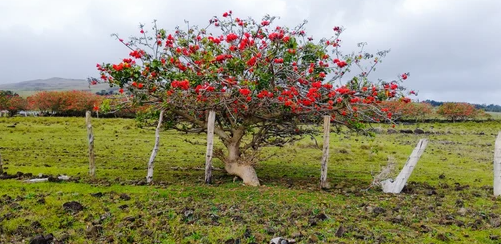The ceibo tree, known scientifically as Erythrina crista-galli, holds a significant position as Argentina National Tree. With its vibrant red flowers and cultural symbolism, the ceibo is an essential part of Argentina's natural heritage. In this article, we will delve into the characteristics, historical significance, ecological importance, distribution, and various uses of the ceibo tree, shedding light on its remarkable contributions to the country's cultural and environmental landscape.
Characteristics of the Ceibo Tree
The ceibo tree is a visually striking species, standing tall with a height of up to 25 meters. It boasts a spreading canopy and a thick trunk covered in thorny bark. One of the most captivating features of the ceibo tree is its vibrant red flowers, which bloom during the summer months. These flowers attract pollinators such as hummingbirds and bees, enhancing the tree's ecological role.
Historical and Cultural Significance of Argentina National Tree
The ceibo tree holds immense cultural importance in Argentina. It has been deeply intertwined with the country's history, folklore, and traditions for centuries. In indigenous beliefs, the ceibo tree is considered sacred and is associated with protection, healing, and spiritual powers. It has also been a subject of various legends and stories, passed down through generations.
Ecological Importance of Argentina National Tree
Beyond its cultural significance, the ceibo tree plays a vital role in Argentina's ecosystem. It serves as a habitat and food source for numerous species, including birds, insects, and mammals. The tree's flowers provide nectar for pollinators, contributing to the overall biodiversity of the region. Moreover, the ceibo tree's extensive root system helps prevent soil erosion, stabilizing the surrounding landscape.
Distribution and Habitat
The ceibo tree is native to various regions of Argentina, including the northeastern provinces and the Paraná Delta. It thrives in subtropical and temperate climates, favoring well-drained soils and areas with abundant sunlight. The tree can be found in both natural habitats, such as forests and riverbanks, as well as urban areas, where it is often planted for its ornamental value.
Life Cycle and Growth
The ceibo tree follows a specific life cycle, starting from seed germination and continuing through various growth stages. Seeds are dispersed by wind or water, and once they find suitable conditions, they sprout and develop into seedlings. As the tree grows, it develops its iconic trunk and branches, with leaves and flowers appearing during the appropriate seasons.
Uses and Benefits
The ceibo tree holds numerous practical uses and benefits. In addition to its cultural and ecological significance, it has found applications in various industries. The durable and lightweight wood of the ceibo tree is utilized in the construction of furniture, crafts, and musical instruments. Its timber is also used for fuel and charcoal production.
Moreover, the ceibo tree possesses medicinal properties. Traditional healers in Argentina have long used different parts of the tree for treating ailments such as respiratory disorders, inflammation, and digestive issues. Studies have shown that certain compounds found in the ceibo tree have anti-inflammatory and antioxidant properties, further highlighting its potential in natural medicine.
Conservation Status of Argentina National Tree
Despite its cultural and ecological importance, the ceibo tree faces certain threats and challenges. Habitat loss due to deforestation, urbanization, and agricultural expansion poses a significant risk to its population. Climate change and invasive species also contribute to the decline of the ceibo tree. As a result, the ceibo is listed as a vulnerable species in Argentina, warranting conservation efforts to protect its existence.
To safeguard the ceibo tree, conservation measures have been implemented. These include the establishment of protected areas, reforestation projects, and raising awareness about the tree's importance. Collaborative efforts between government agencies, conservation organizations, and local communities aim to ensure the long-term survival of the ceibo tree and its associated ecosystems.
Conclusion
The ceibo tree, Argentina's national tree, is a symbol of natural beauty, cultural heritage, and ecological significance. Its vibrant red flowers and rich history have captivated the hearts and minds of people throughout the country. From its uses in various industries to its role in supporting biodiversity, the ceibo tree holds a special place in the collective consciousness of Argentina.
Preserving the ceibo tree and its habitat is of utmost importance to maintain the balance of ecosystems and honor the country's cultural roots. By valuing and protecting this magnificent tree, we can ensure that future generations can continue to appreciate its beauty and benefit from its many contributions.
FAQs
Q: Is the ceibo tree endemic to Argentina?
A: Yes, the ceibo tree is native to Argentina and can be found in various regions of the country.
Q: Are the red flowers of the ceibo tree its only distinguishing feature?
A: While the vibrant red flowers are a prominent characteristic, the ceibo tree also has thorny bark and a spreading canopy.
Q: Can I plant a ceibo tree in my garden?
A: Yes, ceibo trees can be planted in suitable climates and provide a beautiful addition to gardens or landscapes.
Q: Are there any conservation efforts in place to protect the ceibo tree?
A: Yes, conservation measures such as protected areas and reforestation projects aim to preserve the ceibo tree and its habitat.
Q: Are there any other trees that hold cultural significance in Argentina?
A: Yes, besides the ceibo tree, species like the ombú tree and the quebracho tree also have cultural and historical importance in Argentina.
References
- Arboles de Buenos Aires: "Ceibo" - http://www.arbolesdebuenosaires.com.ar/en/ceibo/
- Argentina Travel: "The Ceibo: Argentina's National Tree" - https://www.argentina.travel/en/news/the-ceibo-argentinas-national-tree
- Trees of Argentina: "Erythrina crista-galli" - https://www.arbolesdeargentina.org/erythrina_crista-galli.htm

Excellent Article. I grew up in Argentina and learned to love this tree. Where can I buy one? I would also like a jacaranda. I live in Zone 7. is it too cold here?